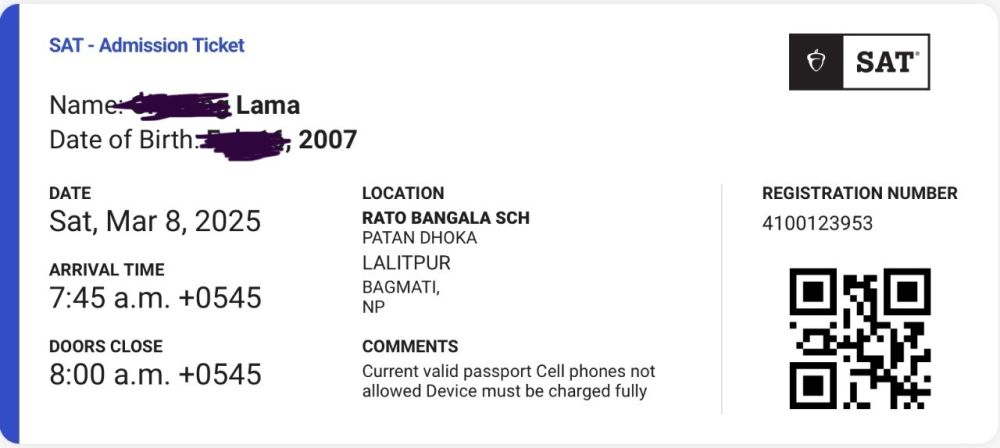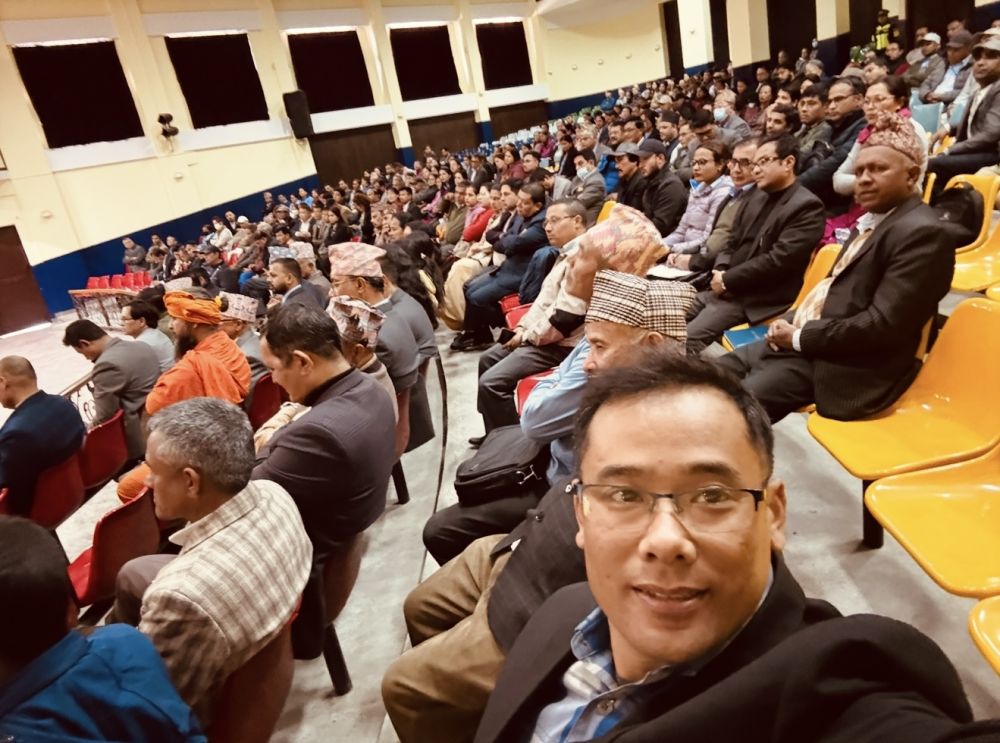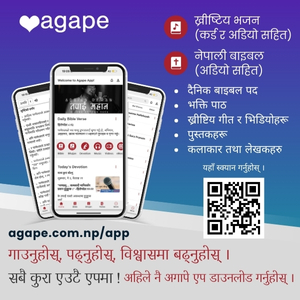Introduction
Life revolves around exams, whether it’s my daughter’s SAT today, the BLE (Basic Level Examination) for 8th graders tomorrow, or my son’s SEE (Secondary Education Examination) next week. However, when comparing the efficiency and cost-effectiveness of these exams, SAT feels like flying on an airplane, while our local exam system feels like a mule carrying a heavy load.
SAT: A Model of Efficiency
My daughter is taking the SAT today, an exam where around 2 million students worldwide participate. The results are published within two weeks. Her exam center is at Rato Bangala School. Since the exam system is digital, she ensured her iPad was charged. The entry process is simple—she just needed a digital admit card and one form of identification, such as a passport or citizenship.
The SAT process demonstrates the effective use of technology in exam administration, from question paper creation to result publication. Filling out the SAT registration form took me only 10 minutes.
BLE: A Bureaucratic Burden
Lalitpur Metropolitan City is conducting BLE for 7,100 eighth graders. Preparing for this exam required two large meetings involving about 300 principals and representatives. Additionally, today, 173 superintendents are being assigned, requiring another meeting. Since all 173 principals are exam center heads, I also attended both meetings.
However, both meetings started late, and even the education officer failed to arrive on time. Collectively, these meetings consumed approximately 3,600 working hours. Today’s superintendent meeting alone will cost around 519 working hours.
Notably, these meetings were largely unnecessary. If required, they could have been conducted via Zoom, saving significant time and resources. Filling out the BLE forms for just 18 students took around 12 hours, meaning each student’s form required about 40 minutes.
SEE: A Costly and Time-Consuming Process
Next week, my son, along with approximately 600,000 students nationwide, will take the SEE exam. Unlike the SAT, SEE requires nearly a year of coaching in both government and private schools. Exam forms are submitted through 77 district education units, with the Examination Control Office incurring an annual cost of approximately NPR 450 million.
One of the most inefficient aspects of SEE is the form-filling process. I personally invested around 6 hours per student just to complete their SEE forms. If we extrapolate this time for thousands of students, the labor hours wasted are staggering. Such a tedious process not only burdens educators but also highlights the inefficiencies deeply embedded in Nepal’s examination system.
SEE is conducted under strict surveillance, involving police forces, schools, and a range of authorities. Despite such efforts, it takes an exhausting 3 to 3.5 months to publish results.
Conclusion
The comparison between SAT, BLE, and SEE reveals stark differences in efficiency. While SAT leverages technology for streamlined administration and swift results, Nepal’s BLE and SEE are burdened by excessive bureaucracy, unnecessary meetings, and prolonged result processing. Moreover, the sheer amount of time wasted on manual form-filling alone suggests the need for urgent reform.
It’s high time Nepalese education authorities rethink their approach to exams, embracing digital transformation to save time, effort, and resources.
परीक्षा प्रणालीको तुलना: छरितोपनको सट्टा बोझ
(मार्च ८, २०२५)
परिचय
मेरो जीवन विभिन्न परीक्षाहरूको वरिपरि घुमिरहेको अवस्था छ—आज मेरी छोरीको SAT, भोलि कक्षा ८ का विद्यार्थीहरूको BLE (Basic Level Examination), र अर्को हप्ता छोराको SEE (Secondary Education Examination)। तर जब दक्षता र लागतको हिसाबले यी परीक्षाहरू तुलना गर्दछ, SAT विमानमा उड्न जस्तो लाग्छ, भने हाम्रो परीक्षा प्रणाली एउटा खच्चडलाई भारी बोकाएको जस्तो लाग्छ।
SAT: एक प्रभावकारी परीक्षा प्रणाली
आज मेरी छोरीले SAT परीक्षा दिइरहेकी छिन्। यो परीक्षामा विश्वभर करिब २० लाख विद्यार्थीहरू सहभागी हुन्छन्। परीक्षाको नतिजा २ हप्ताभित्रै प्रकाशित हुन्छ। उनको परीक्षा केन्द्र रातो बंगला स्कूल परेको छ। SAT पूर्ण रूपमा डिजिटल प्रणालीमा आधारित छ, उनले आफ्नो iPad चार्ज गरेकी छिन। परीक्षामा सहभागी हुन, इमेलबाट आएको एडमिट कार्ड र एउटा परिचयपत्र (पासपोर्ट वा नागरिकता वा नावलिक परिचयपत्र) देखाउदा पुग्छ।
SAT को परीक्षा प्रणाली डिजिटल प्रविधिको प्रभावकारी प्रयोगको उत्कृष्ट उदाहरण हो, जसमा प्रश्नपत्र निर्माणदेखि लिएर नतिजा प्रकाशनसम्म सबै प्रक्रियाहरू सरल, छिटो र पारदर्शी छन्। मैले SAT फारम भर्न १० मिनेट मात्र लगाएँ।
BLE: अनावश्यक झन्झट
ललितपुर महानगरपालिकाले कक्षा ८ का ७१०० विद्यार्थीहरूको लागि BLE परीक्षा सञ्चालन गरिरहेको छ। यस परीक्षाको तयारीका लागि ३ सयभन्दा बढी प्रधानाध्यापक तथा प्रतिनिधिहरूसहभागी भएका दुई ठूला बैठकहरू (युलेन्स स्कूल र सेन्ट जेभिएस स्कूलमा) आयोजना गरियो।
आज १७३ जना सुपरिवेक्षकहरूको बैठक र नियुक्ति कार्यक्रम छ। ती सबै विद्यालयका प्रधानाध्यापकहरू केन्द्राध्यक्षको रूपमा तोकिएका छन्, म पनि दुवै बैठकमा सहभागी भएँ।
तर, दुवै बैठक समयमै सुरु भएनन्, र शिक्षा अधिकृतज्यू पनि समयमा आउनुभएन। यी बैठकहरूले जम्मा गरेर ३६०० भन्दा बढी श्रम घण्टा खर्च गरिसकेको छ, र आज मात्र सुपरिवेक्षक बैठकमा ५१९ घण्टा खर्च हुनेछ।
मुख्य समस्या के हो भने यी बैठकहरू अनावश्यक थिए। यदि बैठक गर्नैपर्ने थियो भने Zoom मार्फत गर्नु उत्तम हुने थियो, जसले समय, स्रोत, र मेहनत बचाउने थियो। १८ जना BLE विद्यार्थीहरूको फारम भर्न मात्रै करिब १२ घण्टा लाग्यो, अर्थात् प्रत्येक विद्यार्थीको फारम भर्न ४० मिनेट लाग्यो।
SEE: महँगो र समय लाग्ने प्रक्रिया
मेरो छोरा, साथै ६ लाखभन्दा बढी विद्यार्थीहरू अर्को हप्ता SEE परीक्षा दिँदैछन्। सरकारी र निजी विद्यालयहरूले परीक्षाका लागि करिब ९ महिना अतिरिक्त कोचिङ गराएका छन्।
SEE परीक्षाका लागि ७७ वटै जिल्ला शिक्षा इकाइहरूबाट फारम भर्नुपर्छ, जसका लागि परीक्षा नियन्त्रण कार्यालयले वार्षिक करिब ४५ करोड रुपैयाँ खर्च गर्छ।
सबैभन्दा अप्रभावकारी प्रक्रिया फारम भर्ने कार्य नै हो। मैले व्यक्तिगत रूपमा प्रत्येक विद्यार्थीको फारम भर्न करिब ६ घण्टा खर्च गरेँ। यदि हजारौँ विद्यार्थीहरूका लागि गणना गरियो भने, यति ठूलो मात्रामा श्रम घण्टा अनावश्यक रूपमा खर्च भइरहेको छ, जुन चिन्ताको विषय हो।
SEE परीक्षा कडा निगरानीमा सञ्चालन गरिन्छ, जसमा प्रहरी, विद्यालय प्रशासन, र विभिन्न निकायहरूको सहभागिता रहन्छ। तर नतिजा प्रकाशित गर्न ३ देखि ३.५ महिना लाग्छ, जुन अत्यधिक ढिलो प्रक्रिया हो।
निष्कर्ष
SAT, BLE, र SEE को तुलना गर्दा नेपालका परीक्षाहरू अत्यधिक बोझिलो, खर्चिलो, र अनावश्यक झन्झटपूर्ण देखिन्छन्। SAT प्रविधिमैत्री, छरितो, र कुशल छ, जबकि BLE र SEE अनावश्यक कागजी प्रक्रिया, बैठकहरू, र लामो समय लाग्ने व्यवस्थाले ग्रसित छन्।
SEE को फारम भर्ने कार्यमै हजारौँ श्रम घण्टा खर्च गर्नु, अनावश्यक बैठकहरूमा प्रधानाध्यापकहरूलाई अल्झाउनु, र ३ महिना कुर्दा मात्र नतिजा पाउने व्यवस्था सुधार गर्नुपर्छ।
अब समय आइसक्यो कि नेपालको परीक्षा प्रणालीलाई डिजिटलाइजेसन गरी छरितो, प्रभावकारी, र समयमै नतिजा प्रकाशन गर्ने प्रणालीको विकास गरियोस्।

























Discussion about this post